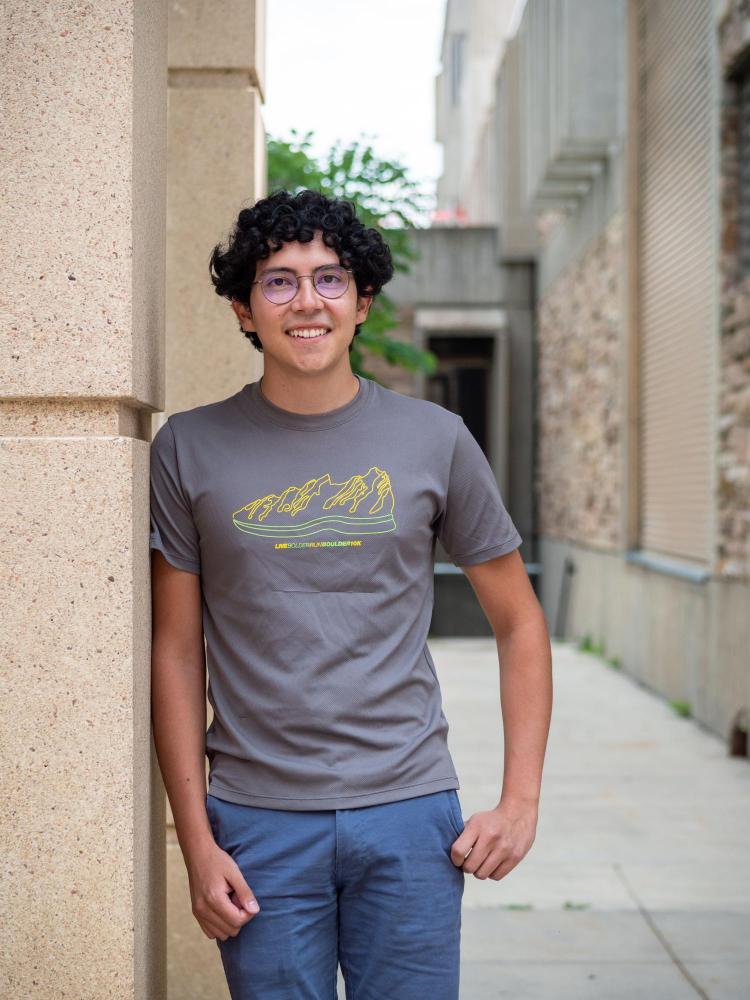Summer intern brings fresh perspective to CU research lab

Jesse Duran working in an engineering lab on campus (Photo by Patrick Campbell/CU Boulder)
Research internships offer undergraduate students opportunities to gain direct experience, as well as build working relationships with professionals in a student’s field of interest.
Jesse Duran, a senior at Fort Lewis College in Durango, spent 10 weeks at CU Boulder this summer working on research projects in the lab of Shu-Wei Huang, assistant professor in the College of Engineering and Applied Science. Huang specializes in ultrafast and nonlinear optics, nanophotonics and microscopy.
Duran’s major is computer engineering with a minor in physics. He has a particular interest in optics.
“You learn a lot from coursework, but having the opportunity to do research is a whole different tier,” he said. “There’s no manual for it. We’re trying to find better ways to do things. My love of science is about going forward and trying novel approaches and contributing to humanity’s knowledge as a whole.”
Hands-on internships are an integral part of college education, especially in engineering disciplines, Huang said. They give students opportunities to see how their knowledge can be applied to solve real problems. Students often learn that real-life problems are far more complex than textbook problems, and they need to come up with educated approximations to find solutions with a reasonable amount of time and resources.

My love of science is about going forward and trying novel approaches and contributing to humanity’s knowledge as a whole.”
–Jesse Duran
“In the past, we have only worked with undergraduate students from CU Boulder,” Huang said.
“Jesse was my first summer intern from another university. It was a fantastic experience for the group. We came to know research that has different flavors than what is offered here in CU Boulder. Jesse also brought in the academic culture of Fort Lewis College that diversifies our ways of thinking and approaches to research in the group.”
One of Duran’s projects this summer involved using a “bare bones” fluorescent microscope for an Environmental Protection Agency project he had been working on in Durango. The goal of the project is to determine the amount of bacteria in the Animas River, which runs through southwest Colorado. Depending on the amount of bacteria, the water can be classified for different recreational uses.
The bare bones reference refers to a microscope made from as few parts as possible. Duran brought a microscope apparatus with him to CU to refine its function with Huang’s help.
“Huang’s knowledge of optics is invaluable for tracking down problems in the system and leading me in new directions for the application of microscopy, Duran said. “This included methodologies for testing each component for the desired functionality.”
With the microscope, Duran can get accurate bacteria counts from water samples taken from the river.
“We are making our process faster using different microbiological methods than traditional plating, which takes at least 24 hours,” he said. “This is a faster way to check for E.coli in the water. It’s easier than plating samples on petri dishes and doing cell counts. The goal is to automate the process without humans having to do it manually.”
Duran’s research is his capstone project for the U-RISE Program, an undergraduate research training scholarship program. U-RISE’s goal is to increase the number of students from underrepresented groups who want to pursue PhDs in biomedical sciences.
Duran worked on another project during his internship using Frequency Resolved Optical Gating (FROG) to measure how fast a laser pulse switches on and off. The FROG measurement helps researchers understand the laser performance and monitor whether lasers are functioning properly. Duran updated the FROG software and modified the hardware to make it faster, more user-friendly and reliable.
“It’s been great working with Shu-Wei and everyone in the lab,” Duran said. “I can take this experience and use it in the lab at Fort Lewis College. The most beneficial part of the experience is the preparation for grad school by seeing how people in a lab interact, and being part of a team with a shared goal and trying to reach it. The experience has influenced me to come back to CU to get my master’s degree to study integrated circuit design. It will be good to have experience in other fields.”
Duran’s EPA project is eye-opening, Huang said, and a perfect example of how engineering skills can be applied to positively change our daily life.
“Jesse has also made significant improvements on the FROG setup that will continue to have impacts on our group's future research,” he said.
Duran’s research experiences this summer helped solidify his growing career interest in teaching science at the college level.
“I was a snowboard instructor for a few years,” he said. “I know what it’s like to be passionate about something and be able to share that passion with people. When I see the progress people make, it’s very fulfilling for me.”


